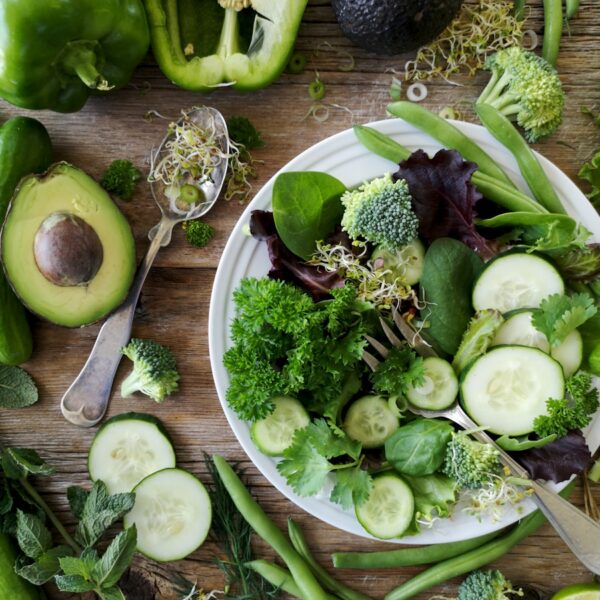7 Powerful Ways to Boost Your Body’s Natural GLP-1 for Weight Loss
Looking to harness your body’s own weight-management hormone? These seven science-backed strategies will help you naturally increase your GLP-1 levels – the same hormone that’s making headlines in popular weight loss medications.
I wish that I could tell you that I have a magic wand and that this post will give you all the answers, the truth is that a healthy weight doesn’t come easily or effortlessly to everyone. Having excess weight is extremely common and it’s often linked to a myriad of health conditions, including heart disease and diabetes. GLP-1 drugs do not work on their own. You still have to put in the work and learn how to eat healthy and nutritious foods for your overall health, so you may as well get started, for FREE.
Almost three out of every four American adults is experiencing overweight or obesity, and it’s no secret that losing weight and keeping it off are very common goals that are exceptionally difficult to reach. While having a healthy lifestyle with the right amount of nutritious foods and exercise is recommended, many people fall short and continue the yo-yo dieting cycle. Sadly, many people achieve weight loss success, only to regain more than half of their weight within a very short period of time.
What is GLP-1?
GLP-1 (Glucagon-Like Peptide-1) is your body’s natural appetite-regulating hormone that helps control hunger, blood sugar, and digestion.
Most help you to feel less hungry, to feel fuller faster, and/or to reduce cravings. They do this by interacting with hormones (e.g., leptin, ghrelin), neurotransmitters (e.g., GABA, serotonin), and peptides (e.g., GLP-1) found in the brain, gut, and fat tissue.
This physiological strategy works because when you feel less hungry, fuller faster, and have fewer cravings, it becomes easier to consume fewer calories, resulting in weight loss. Let’s see how you can boost it naturally.
Strategy 1: Optimize Your Gut Health with Probiotics
Research confirms that certain probiotics can increase GLP-1 production. Beneficial bacteria, particularly Lactobacillus and Bifidobacterium strains, enhance GLP-1 secretion. Include these probiotic-rich foods:
– Kimchi and sauerkraut
– Natural yogurt
– Kefir
– Kombucha
Strategy 2: Time Your Meals with Strategic Fasting
While fasting temporarily decreases GLP-1 levels (since this hormone responds to food), regular fasting can improve your body’s GLP-1 sensitivity over time. All of us are in fasting mode while we sleep. Taking advantage of a 12-14 hour food deficit can be beneficial for most people. The key is breaking your fast with GLP-1-boosting foods. Yes, that means having vegetables at your first meal of the day.
Strategy 3: Load Up on Fiber-Rich Foods
High-fiber foods are GLP-1 powerhouses. Include:
– Leafy greens (spinach, kale)
– Jerusalem artichokes
– Whole grains (oats, barley)
– Legumes (lentils, chickpeas)
– Chicory root
These foods feed beneficial gut bacteria and promote sustained GLP-1 release.
Strategy 4: Incorporate Healthy Fats
Strategic fat consumption slows digestion and promotes sustained GLP-1 release:
– Extra virgin olive oil
– Avocados
– Nuts and seeds
– Fatty fish rich in omega-3s
The key to remember here is that fat is still fat! Too much of these fats will not be beneficial for you.
Strategy 5: Prioritize Protein to Enhance GLP-1 Release
Protein is particularly effective at stimulating GLP-1 production. Focus on:
– Fish
– Lean meats
– Eggs
– Plant-based proteins like tempeh
– Legumes
Strategy 6: Master Your Eating Habits to Boost GLP-1
How you eat matters as much as what you eat:
– Eat slowly and chew thoroughly (30-40 times to help your body with digestion)
– Practice mindful eating
– Space meals appropriately
– Stay hydrated
These habits maximize your natural GLP-1 response.
Strategy 7: Adopt GLP-1-Boosting Lifestyle Practices
Complete your approach with these lifestyle factors:
– Regular exercise to enhance GLP-1 sensitivity
– Adequate sleep (7-9 hours) for optimal hormone production
– Stress management techniques
– Consistent meal timing
Putting It All Together: Sample Day of GLP-1-Boosting Meals
Breakfast:
– Greek yogurt with berries, nuts, and oats
Lunch:
– Lentil soup with olive oil and leafy greens
Dinner:
– Grilled fish with roasted vegetables and quinoa
The Bottom Line
While there is no one-size-fits-all weight loss program, there are some important nutritional guidelines to keep in mind when working toward losing weight:
- A realistic weight loss goal is to lose about one pound per week
- Focus on highly nutritious, filling, fiber-rich foods like fruits, vegetables, and whole grains
- When it comes to meat and dairy, choose leaner cuts and lower fat options
- Minimize less nutritious foods (e.g., fried foods, or those high in sugar or salt)
- Keep portion sizes in check
- Choose water as your main beverage
- Increase the amount of physical activity you do on a regular basis
Choosing more nutritious foods in optimal amounts and increasing physical activity are wise moves for just about everyone’s physical and mental health. Losing 5-10 percent of weight helps to lower triglycerides, blood pressure, and blood sugar levels.
While GLP-1 medications have gained popularity, these seven strategies can help you naturally support your body’s GLP-1 production. Focus on combining these approaches for the best results. Remember that sustainable weight management comes from consistent healthy habits rather than quick fixes.
Want more information on how to get started? Check out my free guide. The Plant-Powered GLP-1 Revolution: A Beginner’s Guide to Natural Weight Loss



Leave a Comment